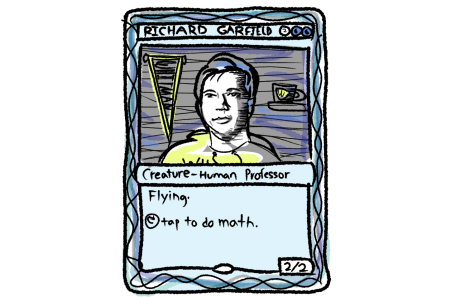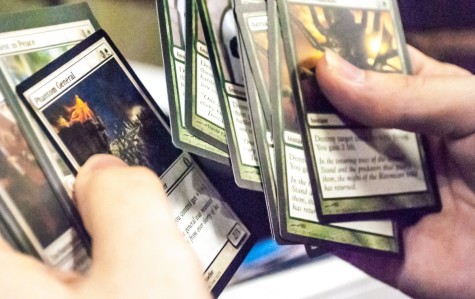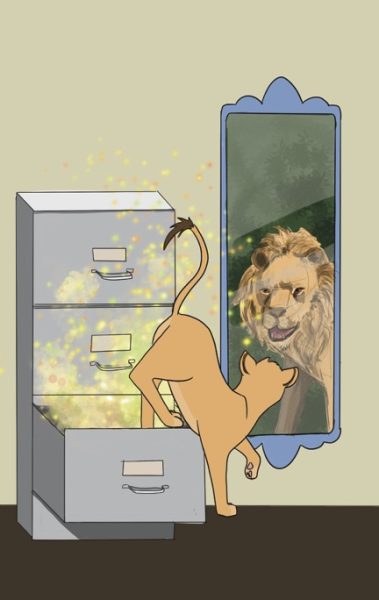The fantastical Walla Walla roots of Magic: The Gathering
October 21, 2021

Magic: The Gathering: one of the most complex games in the world. It predates all other collectable card games like Yu-Gi-Oh!, Pokemon and Hearthstone, and its roots at Whitman have endured as long as the game’s existence. Richard Garfield, the game’s legendary creator, had the idea of customizable decks while hiking through Multnomah Falls, and the final product came out in 1993, while he was a professor of mathematics right here in Walla Walla.
To play Magic: The Gathering (otherwise known as MTG), you start with a friend’s deck or a monstrosity of your own design. On your turn, you perform “upkeep” (untap lands, resolve conditions on the stack, etc.), and then draw a card. Your turn is broken up into phases in which you may attack other players, and the ultimate goal is to meet a win condition faster than your opponents. Seems pretty simple if not for the indefinite production of cards and the myriad of possible deck constructions. Newer cards are designed to be different rather than more or less powerful than existing cards, allowing for interesting combinations and inventive strategies.
MTG’s members at Whitman have been hard to track down, but the community is far from dwindling. While it’s true that the club was swallowed by Tabletop Games (who meet at 7 p.m. in Lyman on Saturdays), factions can still be found sprinkled throughout campus in various basements, hoarding stacks of collectable sleeved cards in pristine condition.
One underground member is first-year Reese Lowenberg.
“I usually only enjoy playing Magic in a non-competitive setting where nobody’s taking the game too seriously and just having a bit of fun,” she said. “It’s a really fun game that allows for a lot of creativity and it’s fun to see how cards can be strung together to maximize their effectiveness, like infinite combos and such.”
According to Lowenberg, the game’s complexity can make it hard for beginners to get into it.
“I think that is part of what makes people shy away from playing, I know I certainly did at first,” she said.
With 20,000 unique cards to choose from and hundreds being added each year, it’s no wonder that it’s intimidating to get started. If you can get past the initial fright, you learn to appreciate the sea of possibilities.
“I think they’ve done a great job in creating a game that allows for a lot of creativity and variation. If you asked 100 Magic players to show you their decks, I doubt any of them will have the exact same one. It’s really cool to see how different each person’s strategy is!” Lowenberg said.
Junior Llewyn Merrill, an avid MTG player, revealed a strategy when it came to his own deck.
“My favourite one is an Abzan Aristocrats deck. That means I have a deck that wins the game by sacrificing my own creatures to gain value and make the opponents lose life. I enjoy it because it feels like a puzzle to play. You have to know what is in the deck to know what you can sacrifice,” Merrill said. “It’s also fun because it seems like it isn’t doing much, until the end of the game when it has these really hard to deal with threats that can’t be solved by killing my creatures.”
To add on to the legendary level of this game, Magic is rich in lore that’s developed and changed ever since its initial conception.
“I really enjoy the depth of culture in the game. Since it’s been around for over 25 years, it has many references to itself. It also has some storylines connecting back to characters who have been developing and changing for 25 years,” Merrill said.
As with any great game, there are minor pitfalls. A common critique of MTG is its tendency to be “Pay to Win” in some formats. A typical competitive deck costs a few hundred dollars, but some people are lucky.
Sophomore Sam Branstad Phillips, a casual dabbler, was able to get into it via a friend. “I never spent a cent on any of the cards, but I learned to play with others’ cards, and eventually a gracious friend gave me a silver-bordered contraption deck he had built,” he said.
A silver-bordered deck is a deck composed of cards that are experimental and use unprecedented mechanics—while funny, most of the time, they are banned from competitive play.
What’s more, is that with certain formats the card list is constantly updating with each season.
“It’s hard to play standard or the newer sets at school because to be competitive you have to buy those new cards and learn about the changes to the format and meta,” Merrill said.
Luckily, Merrill mentioned there are what’s called “evergreen formats” like EDH (Commander) and Modern, where you won’t spend upwards of $600 on a deck that gets banned a day later, which means the meta is anyone’s game.
Lowenberg lists another fair critique. “As of right now, Magic is a very male-dominated game, so I’d definitely like to see more diversity in gender expression just in general. The game can be really fun with the right people!” she said.
Magic can really be played however you want to play it, whether that’s cobbling together whatever spare cards your friend has lying around or if it’s going to Friday Night Magic at your local game shop with your buddies every week. It’s a game with near-infinite possibilities that incorporates lore, creativity and strategy in a riveting battle of wits.
All that being said, MTG took a pretty big hit during the pandemic. Game shops closed, the community shrunk without in-person games and its overall popularity waned. Just prior to COVID-19 hitting, MTG was at an all-time high, and the community is anticipating that trend to continue when tournaments can kick back up. The question is if Magic will listen to these common call-outs and shift towards making the game more accessible for everyone.






